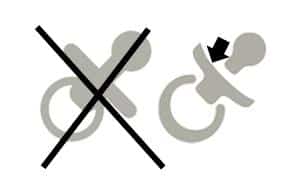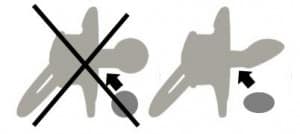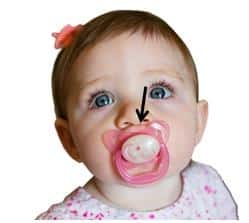For new parents, and especially if the mother is breastfeeding, the choice of using a pacifier or not leads to many questions. What is the best model? Adapted to the age of my baby means what? Should I use latex or silicone?
In this entry:
- Choice of pacifiers and bottle nipples
- Caring for your pacifiers and bottle nipples
- Recommendations for bottle nipples?
- Weaning the pacifier and bottle nipples
At birth, your baby is at a stage where the structures in their face are in full growth. This development will influence their way of breathing, chewing and swallowing. The importance of the muscle work when breastfeeding on their development is considerable. The pressure exercised by their lips, tongue and cheeks will influence the future form of their mouth cavity and jaws.
Starting from birth, you need to make the right choice about pacifiers for your child (and everything else that goes in their mouth). Poorly chosen, a pacifier can potentially create problems for teeth alignment (malocclusion), the width of the palate, breathing, swallowing and more. A pacifier and bottle nipple must be chosen based on the baby’s age. Many models are on the market, made either from latex or silicone.
If you have postnatal breastfeeding problems, your health professional could recommend a pacifier, for the short-term, to fulfill the baby’s sucking needs. They will also try to minimise the risk that the baby will be confused when taking their mother’s breast.
Pacifier and nipples-the difference
The main role of a bottle nipple is to provide liquids. The pacifier is mainly used to satisfy the baby’s sucking needs. Over the past several years, efforts have been made to adapt the form and flexibility of pacifiers and bottle nipples so that they don’t interfere in the child’s proper development. However, even if this is the case, not all pacifiers and bottle nipples are optimally designed.
Breastfeeding and pacifier-risky?
When a mother breastfeeds her baby, naturally the baby must make a sucking effort to stimulate the arrival and ejection reflex of the breast milk. When breastfeeding goes well, the muscles are stimulated properly, which helps the development and growth of the newborn’s mouth and jaw structures. It also meets their natural need to suck. For some babies, breastfeeding sessions will be enough to meet their natural sucking need, while for others it’s not. Some authors suggest that the proper use of a pacifier (a good pacifier) for short controlled periods while properly breastfeeding won’t cause problems. It will also provide the baby comfort and fulfill their sucking needs.
According to the Canadian Pediatric Society, the pacifier may be associated with great benefits under certain conditions, such as painful procedures, self-comfort and non-nutritious sucking for in term and premature infants. For premature, we can even say that the use of the pacifier to satisfy non-nutritive sucking is part of the systematic development at the oromotor level for these children during their neonatal care.
Conversely, others state that the use of a pacifier or bottle nipples too early after birth can cause confusion between breast and pacifier for the baby. This might lead to early weaning. Some worry that a poorly cleaned or contaminated pacifier can cause earaches and respiratory congestion. They also note the risk for potential dental problems when a bad pacifier is chosen.
Pacifier or Thumb?
A very young baby can be comforted in different ways, either with a pacifier or their thumb. They may do it falling asleep, sucking their little fist without a problem. However, you must monitor them to ensure they don’t develop the habit of frequently using their thumb.
Both the Canadian, the American Dental Associations and the Canadian Pediatric Society suggest the use of a pacifier (if it seems necessary) rather than letting the baby use their thumb (or finger) to satisfy their sucking needs. Since it is always easier to break the habit of a pacifier in a child than to suck on their thumb. Sucking the thumb will have more risks for dental problems and complicate weaning. The recommendations of these two institutions also reveal the importance of never allowing them to suck sweet products or let them fall asleep with a bottle, even with milk! These issues can lead to the quick appearance of cavities (bottle cavities). Keep the pacifier and bottle nipple very clean by washing them in hot soapy water before rinsing them.
A rubber pacifier (latex) or a silicone pacifier?
The benefit of rubber (latex) is that it seems to offer more suppleness and flexibility for pacifiers and bottle nipples. This promotes the required muscle work for the baby to develop their jaws. On the other hand, the current industry trend seems to promote the use of silicone. This reassures parents regarding allergies associated with latex, even if they’re infrequent. It must also be said that Health Canada has issued strict rules regarding the use of certain components (nitrosamines), possibly carcinogenic and use to increase the flexibility of rubber pacifiers. Silicone pacifiers and bottle nipples are generally less supple than those made from latex, but are still the trend.
Silicone pacifiers and bottle nipples, because they’re less supple, not facilitate sucking and the optimal development of the child’s facial structures. The suppler a pacifier or nipple, the more functional and preferable it will be. But unfortunately, due to safety concerns, packaging of these products makes it impossible for parents to verify flexibility when choosing.
Are orthodontic pacifiers and nipples better?
Health Canada regulates different aspects concerning pacifiers and nipples to prevent dangers associated with breathing, suffocation and poisoning, but it doesn’t regulate labeling and the use of the term “orthodontic.” The term orthodontic (“ortho” meaning straight) used by the industry is very sketchy. It’s difficult for consumers to make the right choice, as the term orthodontic refers to the form rather than the effect of the product.
Choice of Pacifiers and Nipples
You have to choose the pacifier or nipple based on your baby. It will be different if they’re premature, if they have a small mouth, a deep palate and based on their age of course.
Here is advice from an expert that I met:
What pacifier models are recommended?
My advice is to choose a pacifier that meets the criteria mentioned above.
To read the rest, see Caring for Pacifiers and Nippl
Caring for Pacifiers and Nipples
It’s essential to care for pacifiers and nipples. When you buy them, it’s preferable to boil them and follow the manufacture’s instructions to disinfect them properly before use.
After using a bottle nipple, rinse it with cold water to remove milk residue and sterilize them either in boiling water, in the dishwasher, in an electric sterilizer or in the microwave on a regular basis until the baby is four months old. Then clean it with soapy water and rinse it with the hottest water from the tap.
For pacifiers, disinfect it on purchase and clean it with soapy water and rinse it each time before putting it in your baby’s mouth. Avoid placing it in your mouth to clean it, as you can transmit microbes to the baby that they can’t fight like an adult.
Recommendations for bottle nipples?
Concerning bottle nipples, it’s difficult to suggest a model given all tested nipples seem to let too much milk flow. This means the baby can’t properly work their muscles.
Some nipples are easier to use for a breastfed baby who occasionally receives milk from a bottle. NaturaLatch for exemple is a nipple model that requires that the baby open their mouth wide to receive milk like when breastfeeding. This won’t cause as much confusion when taking their mother’s breast after. However, babies with small mouths or premature babies will need a nipple adapted to their situation before being able to use a regular nipple sold for regular babies.
Weaning the Pacifier and Nipple
The literature doesn’t cite a particular age for weaning. Generally, it’s suggested to progressively stop using the pacifier after two, then only for sleep. Continue the pace with positive messages for your child up to a maximum of three years. This is to avoid potential risks for teething and speech development.
Here is an interesting short video explaining malocclusion in children (in French only):
I hope this article will help you choose from among the many products offered by the industry. It should also help you understand the importance that this choice can have for your little treasure’s health.
Marie Fortier
The Baby Expert






